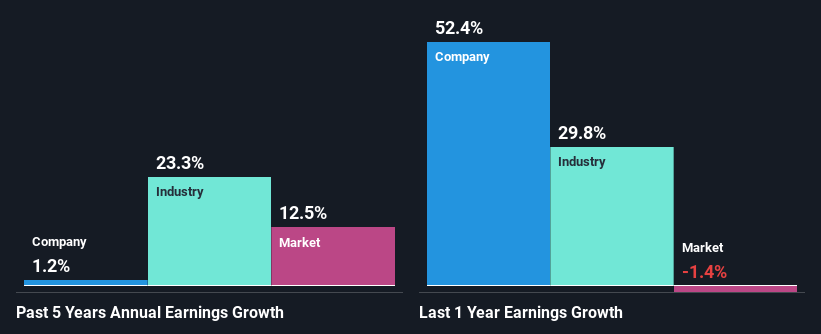Stock Analysis
- United Kingdom
- /
- Food and Staples Retail
- /
- LSE:TSCO
Could Tesco PLC's (LON:TSCO) Weak Financials Mean That The Market Could Correct Its Share Price?

Tesco's (LON:TSCO) stock is up by 2.9% over the past month. Given that the markets usually pay for the long-term financial health of a company, we wonder if the current momentum in the share price will keep up, given that the company's financials don't look very promising. Particularly, we will be paying attention to Tesco's ROE today.
ROE or return on equity is a useful tool to assess how effectively a company can generate returns on the investment it received from its shareholders. In short, ROE shows the profit each dollar generates with respect to its shareholder investments.
View our latest analysis for Tesco
How Is ROE Calculated?
ROE can be calculated by using the formula:
Return on Equity = Net Profit (from continuing operations) ÷ Shareholders' Equity
So, based on the above formula, the ROE for Tesco is:
12% = UK£1.4b ÷ UK£12b (Based on the trailing twelve months to August 2023).
The 'return' is the profit over the last twelve months. Another way to think of that is that for every £1 worth of equity, the company was able to earn £0.12 in profit.
What Is The Relationship Between ROE And Earnings Growth?
Thus far, we have learned that ROE measures how efficiently a company is generating its profits. Depending on how much of these profits the company reinvests or "retains", and how effectively it does so, we are then able to assess a company’s earnings growth potential. Assuming everything else remains unchanged, the higher the ROE and profit retention, the higher the growth rate of a company compared to companies that don't necessarily bear these characteristics.
Tesco's Earnings Growth And 12% ROE
To start with, Tesco's ROE looks acceptable. Even so, when compared with the average industry ROE of 22%, we aren't very excited. Further, Tesco's five year net income growth of 1.2% is more or less flat. Not to forget, the company does have a decent ROE to begin with, just that it is lower than the industry average. So there might be other reasons for the flat earnings growth. For example, it could be that the company has a high payout ratio or the business has alloacted capital, for instance.
We then compared Tesco's net income growth with the industry and found that the company's growth figure is lower than the average industry growth rate of 23% in the same 5-year period, which is a bit concerning.

Earnings growth is an important metric to consider when valuing a stock. It’s important for an investor to know whether the market has priced in the company's expected earnings growth (or decline). By doing so, they will have an idea if the stock is headed into clear blue waters or if swampy waters await. Has the market priced in the future outlook for TSCO? You can find out in our latest intrinsic value infographic research report.
Is Tesco Using Its Retained Earnings Effectively?
With a high three-year median payout ratio of 93% (implying that the company keeps only 6.9% of its income) of its business to reinvest into its business), most of Tesco's profits are being paid to shareholders, which explains the absence of growth in earnings.
Moreover, Tesco has been paying dividends for at least ten years or more suggesting that management must have perceived that the shareholders prefer dividends over earnings growth. Existing analyst estimates suggest that the company's future payout ratio is expected to drop to 49% over the next three years. Accordingly, the expected drop in the payout ratio explains the expected increase in the company's ROE to 16%, over the same period.
Conclusion
In total, we would have a hard think before deciding on any investment action concerning Tesco. While its ROE is pretty moderate, the company is retaining very little of its profits, meaning very little of its profits are being reinvested into the business. This explains the lack or absence of growth in its earnings. With that said, the latest industry analyst forecasts reveal that the company's earnings are expected to accelerate. To know more about the latest analysts predictions for the company, check out this visualization of analyst forecasts for the company.
Valuation is complex, but we're helping make it simple.
Find out whether Tesco is potentially over or undervalued by checking out our comprehensive analysis, which includes fair value estimates, risks and warnings, dividends, insider transactions and financial health.
View the Free AnalysisHave feedback on this article? Concerned about the content? Get in touch with us directly. Alternatively, email editorial-team (at) simplywallst.com.
This article by Simply Wall St is general in nature. We provide commentary based on historical data and analyst forecasts only using an unbiased methodology and our articles are not intended to be financial advice. It does not constitute a recommendation to buy or sell any stock, and does not take account of your objectives, or your financial situation. We aim to bring you long-term focused analysis driven by fundamental data. Note that our analysis may not factor in the latest price-sensitive company announcements or qualitative material. Simply Wall St has no position in any stocks mentioned.
About LSE:TSCO
Tesco
Tesco PLC, together with its subsidiaries, operates as a grocery retailer in the United Kingdom, Republic of Ireland, the Czech Republic, Slovakia, and Hungary.
Undervalued with solid track record.

